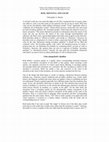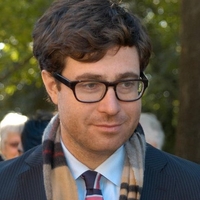Papers by Christopher A Shrock
Journal of Scottish Philosophy, 2019
Restoration and Philosophy, 2019
Since Miranda Fricker introduced the notion of hermeneutical injustice, where one’s social contex... more Since Miranda Fricker introduced the notion of hermeneutical injustice, where one’s social context lacks the requisite linguistic and conceptual resources for responding appropriately to one’s social experiences, others have built on her work by cataloging species of hermeneutical injustice. This paper attempts to uncover such a species. It suggests that Barton Stone and Thomas Campbell considered extra-biblical creeds threats to hermeneutical justice, and they offer biblicism as a remedy. This example is significant, because it presents a heretofore unnoticed possibility of hermeneutical infection, which might involve purging hermeneutical elements rather than enriching them.
A new reading of C. S. Lewis' moral argument for the existence of God.
Thomas Reid claims that color is "the disposition of bodies to reflect a particular kind of light... more Thomas Reid claims that color is "the disposition of bodies to reflect a particular kind of light" (Reid, EIP 204). This is by no means an original or surprising claim. But Reid's approach to color is unusual. In this paper, I explain how a Reidian take on color yields an unexpected response to the problem of metamerism, which is the curious fact that objects with different spectral reflectances may present the same types of color appearances. Two objects may both appear yellow (under the same lighting conditions) even though they have different reflectances.

A red ball is still red, even when the lights are off. But a tuning fork has no sound, unless one... more A red ball is still red, even when the lights are off. But a tuning fork has no sound, unless one strikes it. And a rose that emits no tiny particles into the air has no smell. Why does color survive the darkness while stillness terminates sound? "Color" apparently refers to a different sort of thing than "sound." Thomas Reid, however, insists that color and sound are both secondary qualities. By "secondary quality," Reid means the unknown cause of a known sensation. The senses themselves provide no information about the nature of the cause, but one can discover the nature of the cause through experimentation and induction. By Reid's time, natural philosophers had made some progress in this direction. Reid describes smells as "effluvia of bodies" and sounds as "vibrations." 3 However, he describes color as a disposition of a body to reflect a particular kind of light. 4 Why should color be the only disposition among secondary qualities? It should not be. Reid has confused "color," the secondary quality, with "color," the mechanical power of a body. I propose that one can illuminate the problem by comparing Reid's account of color to Aristotle's. However, this analysis does not end in a rejection of Reidian "secondary qualities" or "mechanical powers." Instead, one may graft the Aristotelian distinction onto Reid's account to form an orderly philosophy of color in Redian terms.
Books by Christopher A Shrock
Coming out in paperback May 2019!
Book Reviews by Christopher A Shrock
Journal of Scottish Philosophy, 2018
Ainslie's Hume's True Scepticism interprets Book I, Section 4 of David Hume's Treatise on Human N... more Ainslie's Hume's True Scepticism interprets Book I, Section 4 of David Hume's Treatise on Human Nature, "Of the sceptical and other types of philosophy," as a mock-autobiographical paradigm shift, from "false" to "true" philosophy. According to Ainslie, Hume begins the work by analyzing vulgar approaches to sense experience, beliefs in physical substances, and beliefs
Journal of Scottish Philosophy, 2018
Journal of Scottish Philosophy, 2015











Uploads
Papers by Christopher A Shrock
Books by Christopher A Shrock
Book Reviews by Christopher A Shrock